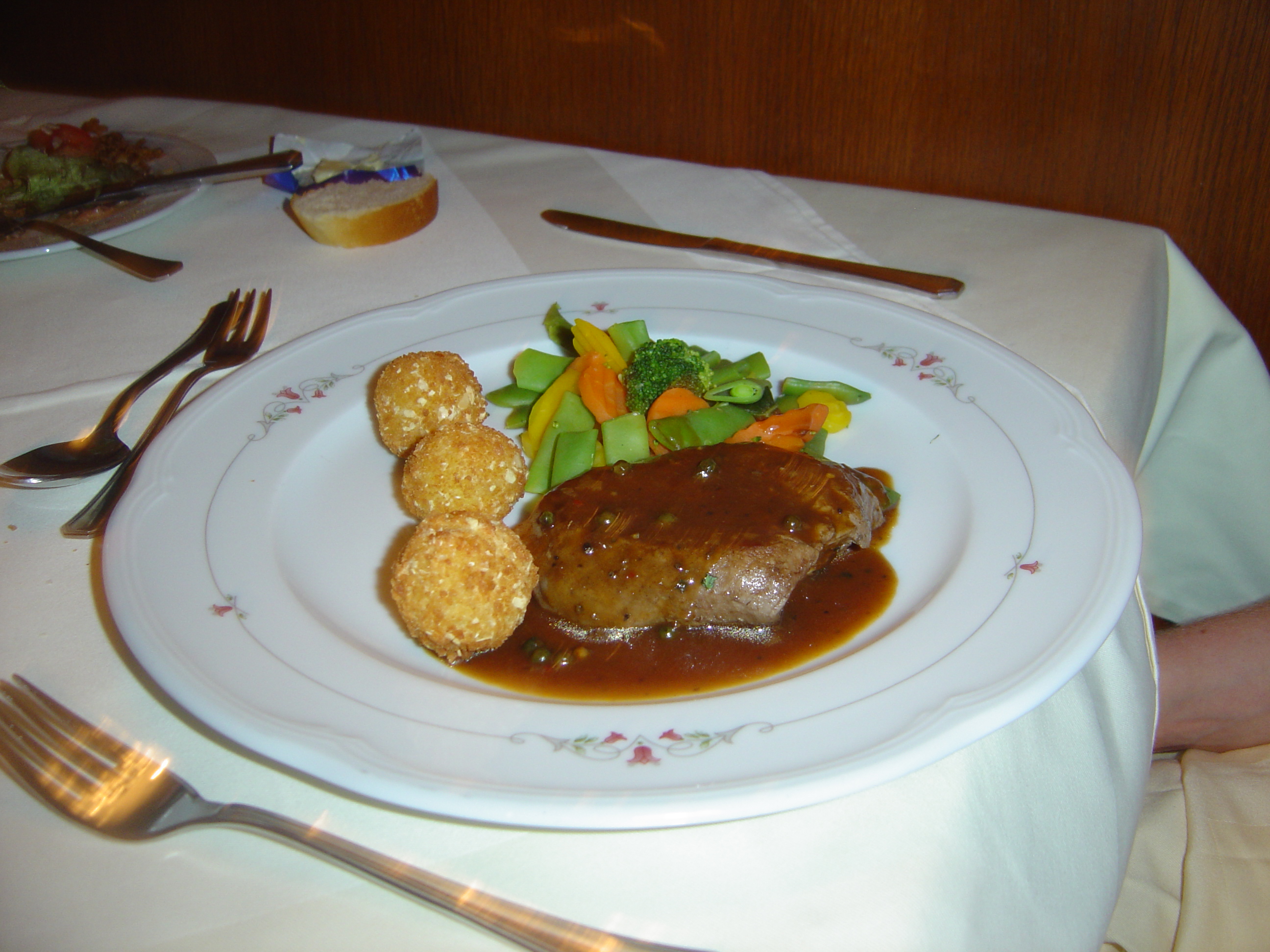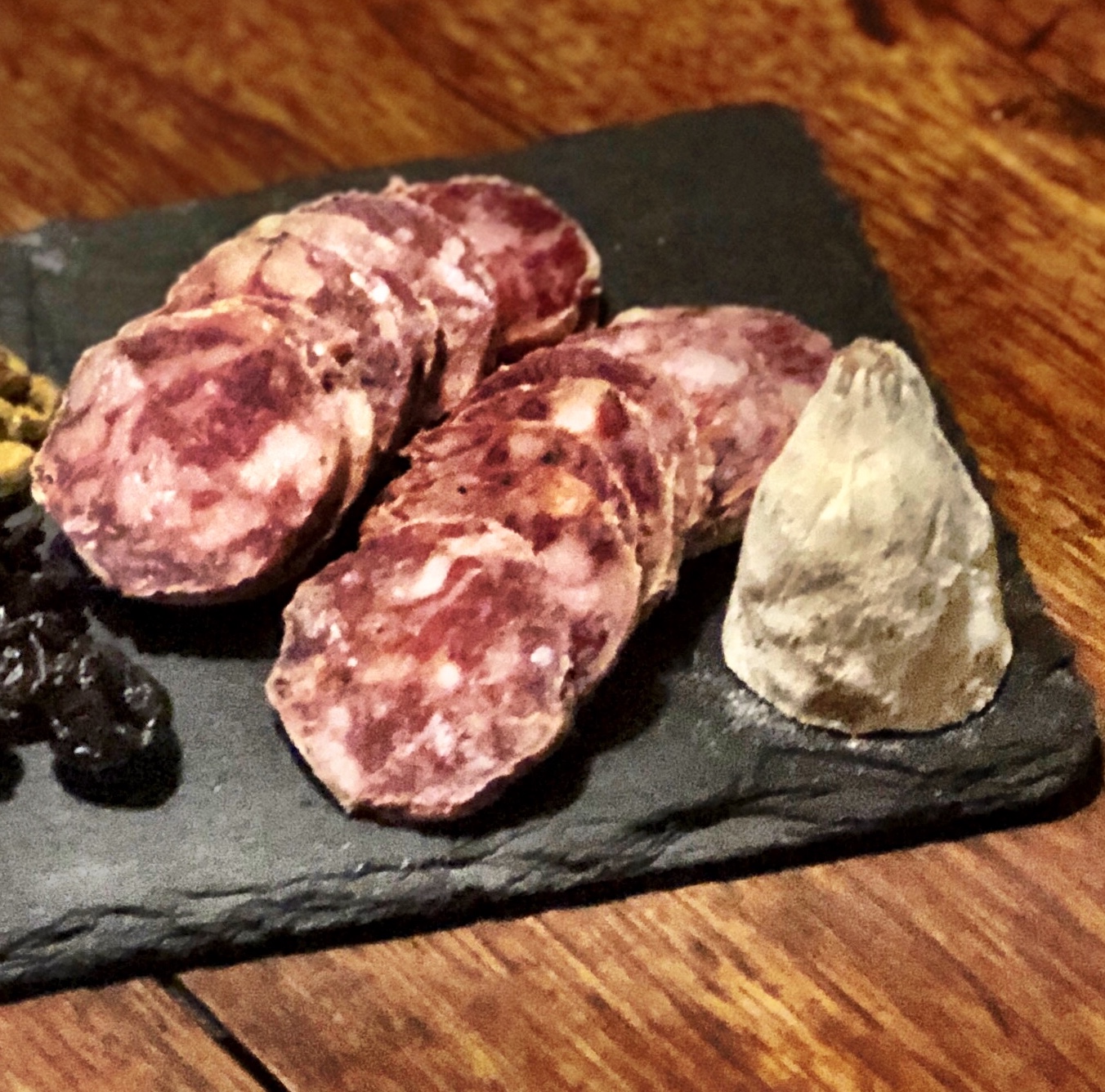|
Chasseur Sauce
''Sauce chasseur'', sometimes called "hunter's sauce", is a simple or compound brown sauce used in French cuisine. It is typically made using demi-glace or espagnole sauce (among the five mother sauces) as a base, and often includes mushrooms and shallots. It may also include tomatoes and a finishing of ''fines herbes''.''Larousse Gastronomique'' (1961), Crown Publishers. Original French edition: Librairie Larousse, Paris (1938) History The name is derived from the French word for "hunter", alluding to the traditional pairings with venison, rabbit, wild fowl, and other game meats. Traditionally, while returning from the hunt, the hunters would pick the mushrooms that they would subsequently use for their preparation. ''Chasseur'' is thought to have been invented by Philippe de Mornay, who is also credited with inventing Mornay sauce, Béchamel, sauce Lyonnaise, and sauce Porto. See also * Brown sauce * Cacciatore * Coq au vin * Hunter's chicken Chicken chasseur (; french: ... [...More Info...] [...Related Items...] OR: [Wikipedia] [Google] [Baidu] |
Brown Sauce (meat Stock Based)
In classical French cuisine, a brown sauce is generally a sauce with a meat stock base, thickened by reduction and sometimes the addition of a browned roux, similar in some ways to but more involved than a gravy. The classic mother sauce example is espagnole sauce as well as its derivative demi-glace, though other varieties exist. Scandinavia In Danish cuisine brown sauce (''brun sovs'') is a very common sauce, and refers to a sauce with a meat stock base (in modern times, often replaced by broth made from bouillon cubes), thickened by a roux, and sometimes colored a rich, deep brown with a product consisting of dark caramelized sugar, known as ''brun kulør'' (literally, "brown colouring") or ''madkulør'' (literally, "food colouring") or collorit soya (in Sweden). It is similar to what is known in the UK as gravy browning and in the U.S. as a brown gravy. Variations include mushroom sauce, onion sauce, and herbed brown sauce. The Norwegian variety (''brun saus'') is made ... [...More Info...] [...Related Items...] OR: [Wikipedia] [Google] [Baidu] |
Fowl
Fowl are birds belonging to one of two biological orders, namely the gamefowl or landfowl (Galliformes) and the waterfowl (Anseriformes). Anatomical and molecular similarities suggest these two groups are close evolutionary relatives; together, they form the fowl clade which is scientifically known as Galloanserae (initially termed Galloanseri) (Latin ''gallus'' (“rooster”) + ''ānser'' (“goose”)). This clade is also supported by morphological and DNA sequence data as well as retrotransposon presence/absence data. Terminology As opposed to "fowl", "poultry" is a term for any kind of domesticated bird or bird captive-raised for meat, eggs, or feathers; ostriches, for example, are sometimes kept as poultry, but are neither gamefowl nor waterfowl. In colloquial speech, however, the term "fowl" is often used near-synonymously with "poultry," and many languages do not distinguish between "poultry" and "fowl". Nonetheless, the fact that the Galliformes and Anseriformes most ... [...More Info...] [...Related Items...] OR: [Wikipedia] [Google] [Baidu] |
Brown Sauces
Brown is a color. It can be considered a composite color, but it is mainly a darker shade of orange. In the CMYK color model used in printing or painting, brown is usually made by combining the colors orange and black. In the RGB color model used to project colors onto television screens and computer monitors, brown combines red and green. The color brown is seen widely in nature, wood, soil, human hair color, eye color and skin pigmentation. Brown is the color of dark wood or rich soil. According to public opinion surveys in Europe and the United States, brown is the least favorite color of the public; it is often associated with plainness, the rustic, feces, and poverty. More positive associations include baking, warmth, wildlife, and the autumn. Etymology The term is from Old English , in origin for any dusky or dark shade of color. The first recorded use of ''brown'' as a color name in English was in 1000. The Common Germanic adjectives ''*brûnoz and *brûnâ'' meant b ... [...More Info...] [...Related Items...] OR: [Wikipedia] [Google] [Baidu] |
Hunter's Chicken
Chicken chasseur (; french: poulet chasseur, and ) is a chicken dish that is a part of French cuisine. The primary ingredients in hunter's chicken are sautéed chicken and a reduced chasseur sauce prepared using tomatoes, mushrooms, onions, white wine, brandy and tarragon. Several other dishes from around the world share these names; yet each version is very different, with few to no similarities besides the use of chicken. Etymology means "hunter" in French, which also refers to the chasseur sauce. Hunter's chicken shares the same literal name as chicken cacciatore in Italy ( means "hunter" in Italian). Overview French hunter's chicken is prepared using sautéed chicken that is cooked crisp and a chasseur sauce consisting of tomatoes, mushrooms, onions, white wine, brandy and tarragon. Prior to sautéeing, the chicken can be dredged in flour. Tomato ingredients can include diced tomatoes, canned crushed tomatoes and canned tomato paste. Additional ingredients in hunter' ... [...More Info...] [...Related Items...] OR: [Wikipedia] [Google] [Baidu] |
Coq Au Vin
''Coq au vin'' (; , "rooster/cock with wine") is a French dish of chicken braised with wine, lardons, mushrooms, and optionally garlic. A red Burgundy wine is typically used, though many regions of France make variants using local wines, such as ''coq au vin jaune'' ( Jura), ''coq au riesling'' (Alsace), ''coq au pourpre'' or ''coq au violet'' (Beaujolais nouveau), and ''coq au Champagne''. History Various legends trace ''coq au vin'' to ancient Gaul and Julius Caesar, but the recipe was not documented until the early 20th century; it is generally accepted that it existed as a rustic dish long before that.Oxford Companion to Food, ''s.v.'' cock A somewhat similar recipe, ''poulet au vin blanc'', appeared in an 1864 cookbook. Simone Beck, Louisette Bertholle and Julia Child included ''coq au vin'' in their 1961 cookbook ''Mastering the Art of French Cooking'', and Child prepared it twice on the PBS cooking show ''The French Chef.'' This exposure helped to increase the visibi ... [...More Info...] [...Related Items...] OR: [Wikipedia] [Google] [Baidu] |
Cacciatore
Cacciatore (, ; ) means "hunter" in Italian. In cuisine, ''alla cacciatora'' refers to a meal prepared "hunter-style" with onions, herbs, usually tomatoes, often bell peppers, and sometimes wine. Cacciatore is popularly made with braised chicken (''pollo alla cacciatora'') or rabbit (''coniglio alla cacciatora''). The ' is a small salami that is seasoned with only garlic and pepper. Preparation A basic cacciatore recipe usually begins with a couple of tablespoons of olive oil heated in a large frying pan. Chicken parts, seasoned with salt and pepper, are seared in the oil for three to four minutes on each side. The chicken is removed from the pan, and most of the fat poured off. The remaining fat is used to fry the onions, peppers or other vegetables for several minutes. A small can of peeled tomatoes (drained of liquid and chopped coarsely) is typically added to the pan along with rosemary and a half cup of dry red wine. Bay leaf may be used, along with chopped carrot to give e ... [...More Info...] [...Related Items...] OR: [Wikipedia] [Google] [Baidu] |
Port Wine
Port wine (also known as vinho do Porto, , or simply port) is a Portuguese fortified wine produced in the Douro Valley of northern Portugal. It is typically a sweet red wine, often served with dessert, although it also comes in dry, semi-dry, and white varieties. Other port-style fortified wines are produced outside Portugalin Argentina, Australia, Canada, France, India, South Africa, Spain, and the United Statesbut under the European Union Protected Designation of Origin guidelines, only wines from Portugal are allowed to be labelled "port". Region and production Port is produced from grapes grown and processed in the demarcated Douro region.Porter, Darwin & Danforth Price (2000) ''Frommer's Portugal'' 16th ed., p. 402. IDG Books Worldwide, Inc. The wine produced is then fortified by the addition of a neutral grape spirit known as aguardente to stop the fermentation, leaving residual sugar in the wine, and to boost the alcohol content. The fortification spirit is ... [...More Info...] [...Related Items...] OR: [Wikipedia] [Google] [Baidu] |
Sauce Lyonnaise
Sauce lyonnaise is a compound or small French sauce of demi-glace, white wine, vinegar and onions served with small cuts of meat principally for left-overs.''Larousse Gastronomique'' (1961), Crown Publishers(''Translated from the French, Librairie Larousse, Paris (1938)'') See also * Lyonnaise cuisine * Lyonnaise potatoes Lyonnaise potatoes – in French pommes de terre sautées à la lyonnaise – are potatoes, boiled and then sliced and shallow-fried, served together with fried onions. History and ingredients The culinary term ''à la lyonnaise'' – in the st ... References {{France-cuisine-stub French sauces Cuisine of Lyon ... [...More Info...] [...Related Items...] OR: [Wikipedia] [Google] [Baidu] |
Mornay Sauce
A Mornay sauce is a béchamel sauce with shredded or grated cheese added. Some variations use different combinations of Gruyère, Emmental cheese, white cheddar or even Parmesan cheese. A Mornay sauce made with cheddar is commonly used to make macaroni and cheese. Etymology The name origin of Mornay sauce is debated. It may be named after Philippe, duc de Mornay (1549–1623), Governor of Saumur and seigneur du Plessis-Marly, writer and diplomat, but a cheese sauce during this time would have to have been based on a velouté sauce because béchamel had not yet been developed. ''Sauce Mornay'' does not appear in '' Le cuisinier Royal'', 10th edition, 1820, perhaps because ''sauce Mornay'' is not older than the seminal Parisian restaurant Le Grand Véfour, where ''sauce Mornay'' was introduced. In the ''Tout-Paris'' of Charles X, the Mornay name was represented by two stylish men, the marquis de Mornay and his brother, styled comte Charles. They figure in Lady Blessington's me ... [...More Info...] [...Related Items...] OR: [Wikipedia] [Google] [Baidu] |
Philippe De Mornay
Philippe de Mornay (5 November 1549 – 11 November 1623), seigneur du Plessis Marly, usually known as Du-Plessis-Mornay or Mornay Du Plessis, was a French Protestant writer and member of the anti-monarchist '' Monarchomaques''. Biography He was born in Buhy, now situated in Val-d'Oise. His mother had leanings toward Protestantism, but his father tried to counteract her influence by sending him to the of the University of Paris. On his father's death in 1559, however, the family formally adopted the reformed faith. Mornay studied law and jurisprudence at the University of Heidelberg in 1565 and the following year Hebrew and German at the University of Padua. During the French Wars of Religion in 1567, he joined the army of Louis I de Bourbon, prince de Condé, but a fall from his horse prevented him from taking an active part in the campaign. His career as Huguenot apologist began in 1571 with the work ''Dissertation sur l'Église visible'', and, as a diplomat in 1572, he un ... [...More Info...] [...Related Items...] OR: [Wikipedia] [Google] [Baidu] |
Game (food)
Game or quarry is any wild animal hunted for animal products (primarily meat), for recreation (" sporting"), or for trophies. The species of animals hunted as game varies in different parts of the world and by different local jurisdictions, though most are terrestrial mammals and birds. Fish caught non-commercially (recreational fishing) are also referred to as game fish. By continent and region The range of animal species hunted by humans varies in different parts of the world. This is influenced by climate, faunal diversity, popular taste and locally accepted views about what can or cannot be legitimately hunted. Sometimes a distinction is also made between varieties and breeds of a particular animal, such as wild turkey and domestic turkey. The flesh of the animal, when butchered for consumption, is often described as having a "gamey" flavour. This difference in taste can be attributed to the natural diet of the animal, which usually results in a lower fat content compar ... [...More Info...] [...Related Items...] OR: [Wikipedia] [Google] [Baidu] |

.jpg)



.jpg)